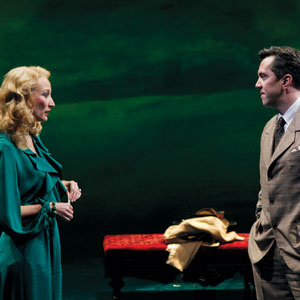BILLY WILDER’s film version of Double Indemnity is so iconic now that it’s easy to forget that originally the story came from a much different book by hardboiled noir writer James M. Cain, who also gave the world The Postman Always Rings Twice and Mildred Pierce.
Part of the reason most people have overlooked Cain’s novel is that Wilder’s film, co-written by Raymond Chandler, is vastly superior. To be fair, it also happens to be my favorite movie of all time, and there’s a certain fanaticism that sets in after 15 or 20 viewings. Cain himself admitted that if he had thought of many of the changes Wilder and Chandler made to his novel, he’d have used them.
That doesn’t mean, however, that Cain’s version should be eclipsed. Even more than his other books, Double Indemnity leans heavily on a ferociously paced, plot-driven style that many have called “economical,” but might also be described as “mechanical”—a good portion of the unforgettable character study we remember from Double Indemnity originated in the film.
But the book mines a different, darker and more extreme vein than the subtler, shades-of-gray Wilder take. First and foremost, the story is about death, and more specifically about a one-woman cult of death named Phyllis. Though movie fans will remember Barbara Stanwyck’s portrayal of a restrained, enigmatic femme fatale, she’s really not much like the Phyllis of the book—who is, not to put too fine a point on it, a psycho bitch from hell.
For their new stage adaptation now on view at San Jose Rep, what playwrights David Pichette and R. Hamilton Wright seem to have realized is that Phyllis is, weirdly enough, a femme fatale for our time. Despite the fact that Double Indemnity was originally serialized in 1936 (and published as a slim novel in 1943, two years before the movie version), Cain’s Phyllis fits in far better among the villains of modern psycho-thrillers than she did in the sultry world of mid-20th-century noir.
Like Basic Instinct’s Catherine Tramell, she kills for thrills; like Fatal Attraction‘s Alex Forrest, she confuses romance and sickness; like Single White Female’s Hedy Carlson, she won’t stop until everyone around her is dead or ruined.
The stage version does borrow from the movie (for instance, there’s no wrap-around narration in the book), but mostly it sticks close to Cain, lifting chunks of dialogue verbatim from the novel and going back to the original names (Walter Huff instead of Neff, Phyllis Nerdlinger instead of Dietrichson, etc). Fans of the film will find it a fascinating alternate universe for that reason alone, but this co-production from San Jose Rep and ACT Seattle stands on its own, as well.
The switch does take some getting used to: John Bogar as Walter Huff—the insurance salesman who gets involved with Phyllis and promises they’ll collect $50,000 from his murder if they can make it look like an accident that falls under his policy’s “double indemnity” clause—doesn’t use a lot of the noir conventions we’re used to. He’s passionate and emotional, and hides his darkness behind a quick smile rather than a deadpan stare.
The same is true with Carrie Paff as Phyllis—emotionally, she’s all over the place. These are the kind of two-fisted, hot-blooded characters Cain populated his stories with, not the droll, ever-cool noir anti-heroes of the movies.
Things speed along nicely in Act I, even when Cain’s shortcomings in the sparkling-dialogue department show. But it’s really Act II that delivers the shocks. Whether one has seen the movie or not, without having read the book there’s no way anyone could guess where Cain took this story. The John GrishamÐtype paranoia and totally bizarre last scene are straight from the book, and they’re fun to watch. The action burns like a fever dream through the whole second half.
As usual, the Rep’s staging is simple and effective. Director Kurt Beattie does incredible things with the fluid, surreal transitions, and lighting director Rick Paulsen nails a perfect noir-nightmare mix of spotlight and shadow.
The only thing I couldn’t accept was the use of the same actors for multiple roles. Since the cast is uniformly excellent in their primary roles, it was distracting to see them filling in for the few incidental parts as well. Why is Richard Ziman, who delivers a fantastic take on Huff’s boss, Keyes (he will stun anyone expecting a retread of Edward G. Robinson from the film), also stuck playing the thankless role of Phyllis’ husband?
It’s a minor complaint, of course—the Rep’s production is a great take on a classic and a true Double Indemnity for our time.
Double Indemnity
Runs through Feb. 5; $29-$74
San Jose Repertory Theatre

 2012 Winter KraftBrew Beer Fest
2012 Winter KraftBrew Beer Fest  Corridors: Exploring the Urban Woodland
Corridors: Exploring the Urban Woodland 


